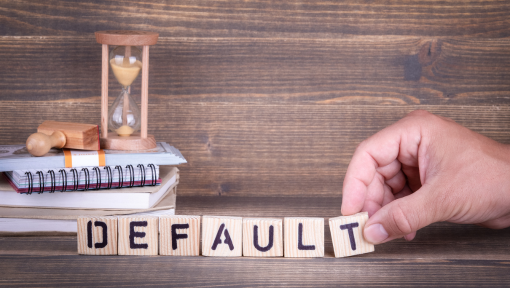Student Loan Repayment Program Consultants
Defaulted Loan Rehabilitation Program
Are you facing default on your student loan and not sure what to do? You are not alone!Understanding Default
Defaulting on your student loan is something more than just missing a couple payments. Once a payment is missed, that loan is deemed “delinquent”. If the servicer doesn’t receive payment within 90 days, the delinquency is reported to the credit bureaus, impacting the borrower’s credit score. After 270 days (nine months) without payment, then a loan officially goes into “default” status. And the consequences of defaulting on a loan can be disastrous.
What happens when a loan enters into default?
- Loan is assigned to a collection agency, which means an abundance of phone calls and letters to borrowers.
- Credit scores are significantly impacted, affecting your ability to get an auto loan, mortgage, credit card, or even rent. If you are able to get er interest rates if you do manage to get a loan.
- The entire outstanding loan balance becomes due immediately. This balance continues to collect interest and late fees, which can add years to your repayment schedule.
- Eligibility for loan benefits, e.g., additional student aid, deferment, payment forbearance, loan forgiveness, and even tax benefits, is lost, making it even more difficult to catch up on payments than before!
- Wage garnishment and/or tax offset
- Legal action: Lenders may sue borrowers to collect garnished wages. You may then also be charged for any court or lawsuit-related costs.

Options for dealing with default:
- Immediate repayment of loans in full
- Discharge due to death or fraud
- Loan consolidation
- Loan rehabilitation (a somewhat slower option, but one that has a number of distinct benefits)
What is Loan Rehabilitation?
Loan rehabilitation is a one-time opportunity to get your loan out of default status by making nine payments in a ten-month period (which means you can miss one payment over the course of ten months). Best of all, these will be reasonable payments based on your current financial situation. Your loan servicer will calculate a monthly payment amount equal to 15% of your discretionary income (the same formula that would be used to calculate an income-based repayment plan.) If that’s still too high, with appropriate documentation of your income and expenses, you can ask them to recalculate a lower amount, which could be as low as $5! Make this new, lower payment for nine out of ten months, and your loan will come out of delinquent status.
At that point, if you’ve been facing wage garnishment and tax offsets, those will stop. Your default will even be removed from your credit history! (Any late payments you made will remain in your credit report, but the more serious notation of “default” will be removed.) To keep you in good standing, you’ll once again be eligible for loan modification and payment plans, along with any forbearance, deferment, or forgiveness options that were lost because of default.
Once your loan is rehabilitated, you’ll be working with a new loan servicer, so you’ll want to be sure to discuss all of your available options with that new servicer to be sure you stay on top of your new payment plan because you will not get this opportunity again. Loan rehabilitation is a one-time option, and you will not be permitted to enter into a loan rehabilitation agreement again.
There are a few exceptions to this: If you rehabilitated a loan before August 14, 2008, though, you will have the chance for loan rehabilitation just one more time. If you get out of default through Fresh Start, it will not count as your one opportunity. (More on that below.)
Taking Advantage of Loan Rehabilitation
If loan rehabilitation sounds like the path you need to get your student loan out of default and stop collections activity, wage garnishment, and all the other negative effects of default, contact us now!
We’ll guide you in contacting your loan servicer or collection agency to get the loan rehabilitation process started. You’ll enter into a written agreement to make nine affordable payments over the course of ten months. You’ll make each of those nine payments within 20 days of the due date. Your default status will be removed, and you’ll be eligible to negotiate a new payment plan. You’ll even be eligible again for further loans and federal student aid!
A Fresh Start for Federal Student Loan Borrowers in Default
Fresh Start is a temporary program from the U.S. Department of Education (ED) that offers special benefits for borrowers with defaulted federal student loans. Fresh Start ends Sept. 30, 2024. Fresh Start automatically gives you certain benefits, such as restoring access to federal student aid (loans and grants), but you need to act to claim the full benefits of Fresh Start and get out of default.
To use Fresh Start to get out of default, you must contact your loan holder. If your loans are held by ED, you can contact them using one of the three methods below. If your loans are held by a guaranty agency, you’ll need to call that agency. If you don’t know who holds your loans, call 1-800-621-3115. You must enroll in Fresh Start before Oct. 1, 2024.
- Defaulted Direct Loan Program loans
- Defaulted Federal Family Education Loan (FFEL) Program loans
- Defaulted Perkins Loans held by ED
- Defaulted Perkins Loans held by schools
- Defaulted Health Education Assistance Loan (HEAL) Program loans
- Student loans remaining with the U.S. Department of Justice for ongoing litigation
- Direct Loans that default after the end of the COVID-19 student loan payment pause
- FFEL Program loans that default after the end of the COVID-19 student loan payment pause
- FFEL Program loans that defaulted during the COVID-19 payment pause will be taken out of default as a result of the expansion of COVID-19 relief. These loans aren’t eligible for Fresh Start.
Here’s what will happen if you use Fresh Start to get out of default:
- ED will transfer your defaulted loans from the Default Resolution Group (or from a guaranty agency) to a loan servicer.
- ED will return your defaulted loans to “in repayment” status.
- ED will remove the record of your default from your credit report.
- You’ll receive communication from your new loan servicer once your loans have been transferred.
After your loans are taken out of default, you’ll automatically be assigned to the Standard Repayment Plan. Most borrowers enrolling in Fresh Start (about 80 percent), however, choose to apply for an income-driven repayment (IDR) plan. An IDR plan bases your monthly payment amount on your income and family size. (It is generally a percentage of your discretionary income.) Unlike a standard repayment plan, at the end of the IDR-plan repayment period, the remaining balance is forgiven. You cannot apply for an IDR plan until ED completes processing your Fresh Start enrollment, though. This will likely take at least a few weeks.
Benefits to enrolling in Fresh Start
- Access to Federal Student Aid: You can apply for federal grants and loans if you want to go back to school.
- Stopped collections
- Tax refunds (and child tax credits) will not be withheld
- Wages will not be garnished
- Social Security payments (including disability benefits) will not be withheld
- Collection calls will not be made
- Eligibility for other government loans: Many lenders, especially for loans that are backed by the government, will reject applicants who are marked as “in default” in the government credit reporting system (CAIVRS).
- Restored ability to rehabilitate loans: Normally, you can only rehabilitate a loan one time, but Fresh Start will not count as your one chance at rehabilitating your loan(s). For example: let’s say you’ve never rehabilitated your loan before and you use Fresh Start to get out of default; then, later on, your loan goes into default again. In this case, you would still have the option to rehabilitate your loan. If you rehabilitated your loan(s) during the COVID-19 student loan payment pause, that also will not count as your one chance at rehabilitating your loans.
- Changes to credit reporting
- Access to IDR plans
- Access to apply for loan forgiveness programs
- Access to short-term relief like forbearance and deferment
If your loan(s) enter into default again later…
If you go into default again after Fresh Start, ED will use your loan’s original date of delinquency in the information provided to credit reporting agencies. That means that Fresh Start won’t reset how long credit reporting agencies report your loan as delinquent or in default.
If you’ve been delinquent on a loan for more than seven years, that defaulted or delinquent loan doesn’t show up on your credit report anymore. If you’re in this situation, ED will make sure you won’t get a default or delinquency reported for the loan anymore. So, if you take advantage of Fresh Start but default or become delinquent again, that defaulted loan won’t show up on your credit report if it has been at least seven years since you first became delinquent on the loan.
If you take out a new loan during or after Fresh Start, that new loan won’t be affected by Fresh Start, so if you default on the new loan, it will be reported to credit reporting agencies, and you will experience all the regular effects of default.
Learn more about your options today
If you are in default on your student loan, all is not lost. Options are available to you, and there’s no better time to act than now. Contact us today to find out the best option for you!

Select Page